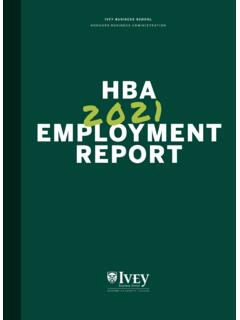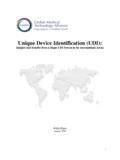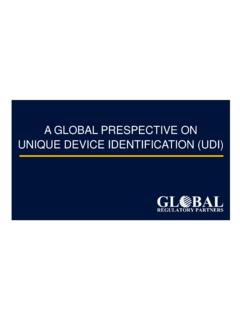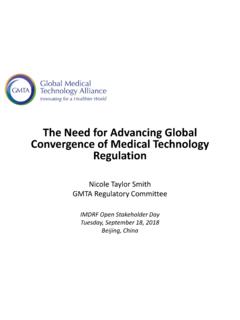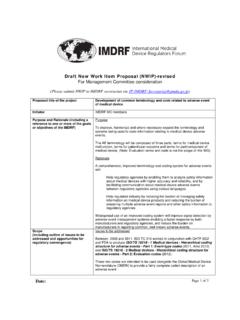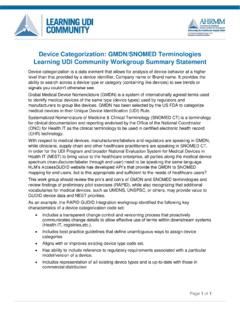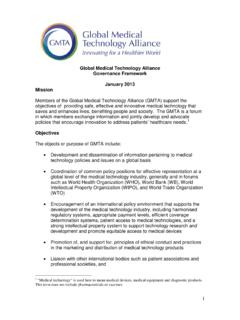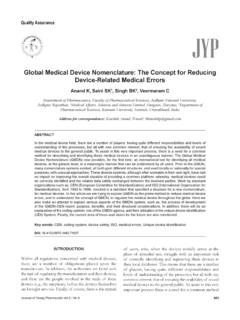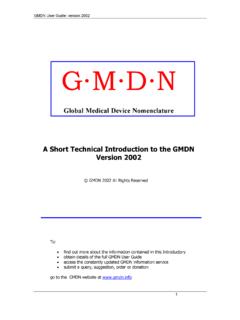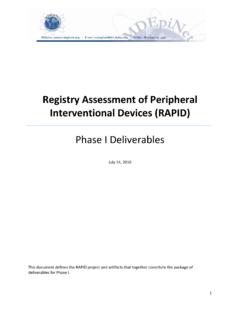Transcription of Models for Global Medical Device Supply Chain Standards.
1 May 2018 Models for Global Medical Device Supply Chain Standards. BEST PRACTICES FOR nomenclature AND UNIQUE Device IDENTIFICATION STANDARDS FOR CANADA ii Ivey International Centre for Health Innovation We are a Centre of Excellence located within the Ivey Business School at Western University. Since our inception we have been an objective third party academic centre, working to take proven health sector innovations and implement them into the system using evidence-based methods. Core to the Centre s mission is brokering relationships that spur innovation and foster a collaborative process to ensure the successful implementation and sustainable adoption of innovative ideas, processes, Models and technologies. The Centre is ideally situated to broker value-based innovation within the province of Ontario, Canada and abroad.
2 Building off of Ivey s mission to, develop business leaders who think globally, act strategically, and contribute to the societies in which they operate , the Centre is ideally positioned to lead a value-based, healthcare system transformation. For more information, please visit our website at Models for Global Medical Device Supply Chain Standards. Best Practices for nomenclature and Unique Device Identification Standards for Canada iii Executive Summary Supply Chain management and optimization has become a priority area for Global health systems due to increasing complexity of healthcare Supply chains and the availability of IT solutions capable of automated Supply Chain management and advanced analytics. Initiatives to promote the efficiency and effectiveness of materials management have been largely motivated by cost savings, but are reaping multiple benefits including promoting patient safety, reducing Medical errors, and promoting patient outcomes measurement and tracking.
3 As health systems are becoming increasingly globalized, particularly related to multi-national Device manufacturers, ensuring that all health system product data systems are aligned and interoperable is becoming increasingly important. One approach to managing this challenge is the adoption of Global standards which ensure that data systems are using the same terminology and technology so that processes can be standardized internationally. In the healthcare industry, there are two key standards types to identify product information: (1) unique Device identification (UDI) standards, which standardize product labelling and barcode information; and (2) nomenclature standards, which standardize how devices are named and categorized: Unique Device Identification (UDI): A product identifier, usually in the form of a barcode, which has standardized product information such as a Device labeller, batch number, serial number, expiration date, and date of manufacture.
4 nomenclature : A coding system used to describe Medical Device categories. The benefits of both UDI and nomenclature standards include reducing medication errors, enabling end-to-end Supply Chain visibility, facilitating effective product recalls, tracking of Medical products, enhancing inventory management, supporting regulatory compliance, and automating reimbursement and replenishment processes. Adoption of these standards has spread across the United States and Europe, but Canadian adoption has been limited to date. Some Canadian manufacturers are currently subscribing to Global standards, particularly multi-national companies, but few hospitals are ready to capture this data. This research engaged the perspectives of 30 health system leaders with expertise in Supply Chain transformation and UDI and nomenclature standards, in order to meet the following objectives: Introduce the concepts and benefits of UDI and nomenclature standards; Identify and examine different current state Models for Supply Chain standardization from multiple countries and industries; Provide an objective analysis on which standard (or blend of standards) is most efficient from a health system perspective for both UDI and nomenclature ; Make recommendations for the future state standards model selection and design for the Canadian health sector.
5 And Propose implementation and change management strategies for health sector Supply Chain standards adoption in Canada for manufacturers, government, and delivery organizations, taking into account enablers, capabilities, and capacity for adoption. iv 1. Unique Device Identification Unique Device identifiers (UDI) are a common, agreed-upon standard used by Medical Device manufacturers, government regulators, hospitals, and shared services organization (SSO) Supply Chain managers to track and trace product use. They are typically in the form of a product barcode, which is issued to a manufacturer by a standards organization. Product information ( , serial number, batch number, manufacturer, etc.) is uploaded by the manufacturer into a datapool, which is then accessible to healthcare delivery organizations.
6 Healthcare delivery organizations can then link product information to a patient record, leading to complete end-to-end Supply Chain visibility of specific products. In Canada, manufacturers, who often sell to multiple countries, are well-positioned to label all of their products with UDI in the near future (3-5 years). Key challenges to address in the midterm include: selecting a common database to upload UDI information to; ensuring that all UDI attributes are clearly defined; and determining processes to label variable units of measure ( , ensuring proper labelling on a product case, box, and individual item). The state of hospital readiness for UDI capture in Canada is much less-developed. Participant interviews revealed that many hospitals are not yet planning to integrate UDI, and most hospitals in Canada do not have the necessary data system integration capabilities to capture UDI.
7 In particular, hospitals need to have their electronic health record (EHR) and enterprise resource planning systems (ERP) fully integrated, and invest in point-of-use barcode scanning in order to prepare for UDI. Aside from IT investments, hospitals need access to one single source to retrieve all UDI information. Currently, hospitals that wish to capture UDI information need to make requests with multiple individual vendors and third-party datapools. Implementing a UDI policy requires three key decisions: Selecting a Policy Model: This report analysed a variety of national implementations of a UDI policy in the United States and across Europe. Several options for implementing a policy were identified, including a single government body setting overarching standards, a private sector company setting standards mandated by government, or an industry collaboration who develop voluntary standards.
8 Participants proposed adopting the US Food and Drug Administration (FDA) UDI Rule model. The UDI Rule was implemented in 2014 as a mandatory policy for manufacturers, including a 7-year phased adoption period based on Medical Device classification. Participant feedback indicates this process was effective and well-received. Participants recommended adding hospitals and SSOs to the scope of the mandate, recommending a similar 7-year adoption timeline for manufacturers, with a 10-year adoption timeline for hospitals (providing time to invest in EHR and ERP system integration). Recommendation: The US FDA UDI Rule should be adopted for Canadian implementation of UDI standards. Select differences in implementation are highlighted in Section Implementation Strategies.
9 Models for Global Medical Device Supply Chain Standards. Best Practices for nomenclature and Unique Device Identification Standards for Canada v Selecting a Common UDI Standard: UDI standards (including what information is required in a barcode, how the information is presented, and how the information is collected) are set by a single standards organization. Standards organizations can be broad in the sectors they serve, or can be specific to a product type. For example, GS11 standards are globally available for multiple sectors and multiple product types. Other standards organizations exist which focus on one type of product ( , ICCBBA2 sets standards for blood products) or one specific industry sector ( , HIBCC3 sets standards for the Medical Device industry).
10 Most standards are interoperable and international. Participants proposed having multiple issuing agencies for UDI, similar to the US approach. However, the main UDI standard should be the GS1 GTIN4, which already has significant 90%+ adoption in the US. Recommendation: Adopt the GS1 GTIN as the preferred UDI standard. Other standards should also be accepted, provided that they align and are interoperable with UDI standards. Selecting a Common UDI Database: Rather than sending product information to hospitals directly, manufacturers who subscribe to UDI standards can upload product information to a datapool. Datapools collect and aggregate information from a variety of vendors and share relevant product information with healthcare delivery organizations.


